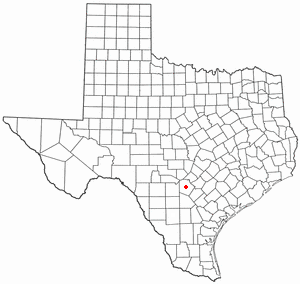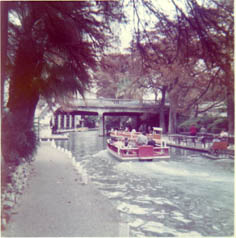San Antonio
San Antonio is a city in the U.S. state of Texas. As of the 2000 census, the city had a resident population of 1,144,646. It is the county seat of Bexar County6.
Originally founded by Canary Islanders in 1731 (although a small Indian community had already been established in the San Pedro Springs area called Yanaguana), San Antonio de Béxar was an early Spanish settlement in the Americas. The Battle of the Alamo took place nearby in 1836, and eventually the town would grow to encompass the embattled mission. Today, the Alamo is in the heart of downtown San Antonio.
Famous for its Riverwalk and the Alamo, and being home to SeaWorld and Six Flags theme parks, San Antonio is visited by 20 million tourists per year.
The city is home to Fort Sam Houston, Lackland Air Force Base, Randolph Air Force Base, and Brooks City Base.
San Antonio is home to the state's first art museum (Marion Koogler McNay Art Museum).
SBC Communications and Clear Channel Communications are headquartered in San Antonio.
San Antonio is served by San Antonio International Airport.
The Fairmont Hotel, built in 1906, is in the Guinness Book of World Records as the heaviest building ever moved intact. It was placed in its new location, three blocks south of the Alamo, over 4 days in 1985, and cost $650,000 to move.
Tourism
San Antonio is a popular tourist destination. The jewel of city is the Paseo del Rio, or River Walk, which meanders through the downtown area. Lined with numerous shops, bars, and restaurants as well as the Arneson River Theater, this attraction is transformed into an impressive festival of lights during the Christmas and New Year holiday period.
The downtown area also features HemisFair Park (home of the Tower of the Americas and the Institute of Texan Cultures), La Villita, El Mercado, and the city's most widely recognized landmark, the Alamo.
Other places of interest include Brackenridge Park (home of the San Antonio Zoo), the missions of the San Antonio Missions National Historical Park, the Witte Museum, the McNay Art Museum, SeaWorld of Texas, and the Six Flags Fiesta Texas theme park.
Every April, San Antonio hosts Fiesta San Antonio, a 10-day celebration of the city's diverse cultures and of the heroes of the Battle of the Alamo and the Battle of San Jacinto. Visitors can also experience something of the cowboy culture every February at the San Antonio Stock Show and Rodeo; year round, they can also see the 40 ft. tall cowboy boots at North Star Mall.
Beyond taking in the sights and sounds of San Antonio, tourists can sample some of its world famous Tex-Mex cuisine at the many fine restaurants located throughout the city. San Antonio also has no shortage of establishments offering Texas style barbecue, and for the truly intrepid barbecue aficionado, a day trip to some of the more renowned barbecue pits and smokehouses of Central Texas is both necessary and easily manageable.
Geography

According to the United States Census Bureau, the city has a total area of 1,067.3 km² (412.07 mi²). 1,055.6 km² (407.56 mi²) of it is land and 11.7 km² (4.51 mi²) of it is water. The total area is 1.09% water.
Demographics
According to the 2000 census, San Antonio is the 9th largest city in the United States and the third largest in Texas. There are 1,144,646 people, 405,474 households, and 280,993 families residing in the city. The population density is 1,084.4/km² (2,808.5/mi²).
There are 433,122 housing units at an average density of 410.3/km² (1,062.7/mi²). The racial makeup of the city is 67.68% White, 6.82% African American, 0.84% Native American, 1.57% Asian, 0.09% Pacific Islander, 19.34% from other races, and 3.66% from two or more races. 58.66% of the population are Hispanic or Latino of any race.
There are 405,474 households out of which 35.9% have children under the age of 18 living with them, 48.1% are married couples living together, 16.4% have a female householder with no husband present, and 30.7% are non-families. 25.1% of all households are made up of individuals and 7.6% have someone living alone who is 65 years of age or older. The average household size is 2.77 and the average family size is 3.36.
In the city the population is spread out with 28.5% under the age of 18, 10.8% from 18 to 24, 30.8% from 25 to 44, 19.4% from 45 to 64, and 10.4% who are 65 years of age or older. The median age is 32 years. For every 100 females there are 93.5 males. For every 100 females age 18 and over, there are 89.7 males.
The median income for a household in the city is $36,214, and the median income for a family is $41,331. Males have a median income of $30,061 versus $24,444 for females. The per capita income for the city is $17,487. 17.3% of the population and 14.0% of families are below the poverty line. Out of the total people living in poverty, 24.3% are under the age of 18 and 13.5% are 65 or older.
Education
San Antonio hosts several institutions of higher education offering bachelor's degrees or higher, including:
- Our Lady of the Lake University[1]
- Saint Mary's University
- Trinity University
- University of the Incarnate Word[2]
- University of Texas at San Antonio[3]
Sports
- San Antonio Missions, Texas League Minor league baseball
- San Antonio Rampage, American Hockey League
- San Antonio Silver Stars, Women's National Basketball Association
- San Antonio Spurs, National Basketball Association
- San Antonio Golf
Nightlife
Popular Hot spots:
Neighborhoods
San Antonio has several neighborhoods of interest:
- The Monte Vista National Historic District is located one and a half miles north of downtown San Antonio and is home to approximately 3,000 people. Its distinguished residential architecture, primarily from San Antonio's "Gilded Age," defined as extending from 1890 to 1930, forms the most extensive and intact neighborhood of this era in Texas.
- The King William Historic District is just south of the central business district of San Antonio. It comprises parts of some twenty-two blocks with seventy-nine historic structures, most dating from the second half of the nineteenth century.
- The northeast suburb of Windcrest is known for its tradition of elaborately decorating homes with lights every Christmas.
- The North Central side of San Antonio contains some of the most valuable residential property in the city. The city of Alamo Heights is populated with historically wealthy families. Inwood just inside Loop 1604 is where many newly upper class residences are located.
- The southeastern suburb of China Grove has a song written and sung about it by the Doobie Brothers entitled "China Grove."
- Downtown has a growing residential population. It is surprisingly affordable to live in the downtown area, although there can be a waiting list for an apartment to open up. Another benefit is that rush hour traffic is generally going in the opposite direction. The only thing missing is a grocery store! While the bus system (VIA Metropolitan Transit) is not ideal, it is far better than most mass transit systems in the US.
Notable Natives
Henry Cisneros was the mayor of San Antonio from 1981 to 1989. He was the first Hispanic mayor of a major U.S. city, and later went on to serve as the Secretary of Housing and Urban Development under President Bill Clinton.
San Antonio NFL players include Keith Cash and Kerry Cash (Holmes High School) and Priest Holmes (Marshall High School).
Shaquille O'Neal graduated from Cole High School, having led his team to a 36-0 record and a state championship his senior year.
Native actors include Carol Burnett and Ann Prentiss.
Olympic gold medalist swimmer Josh Davis was born in San Antonio on September 1, 1972, the same day Mark Spitz won one of his seven 1972 gold medals and made Olympic history.


